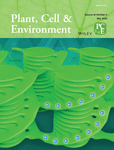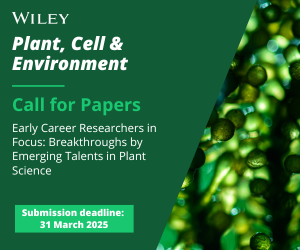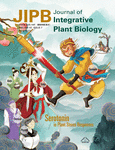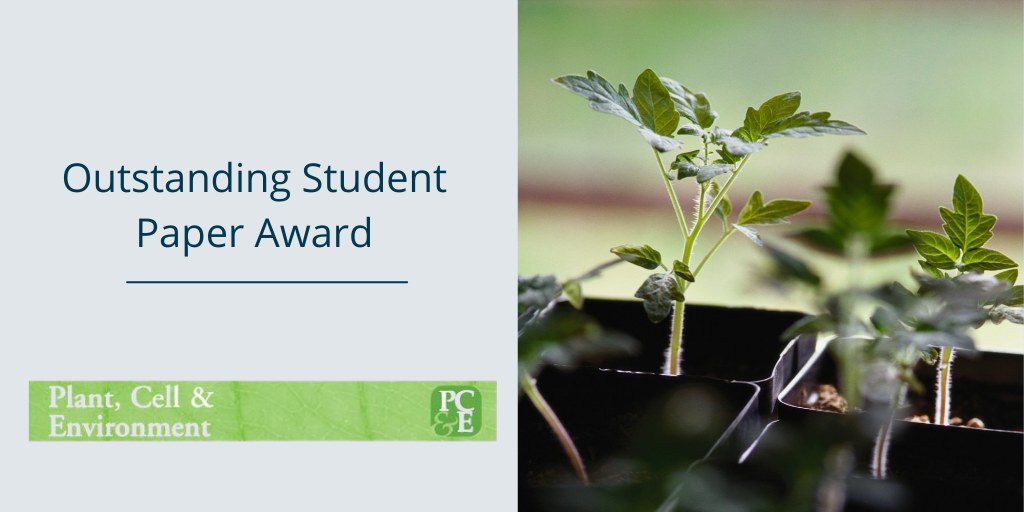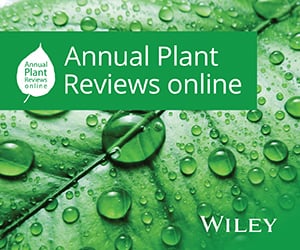Journal list menu
Export Citations
Download PDFs
COVER IMAGE
Cover Image
- Page: i
- First Published: 05 April 2023
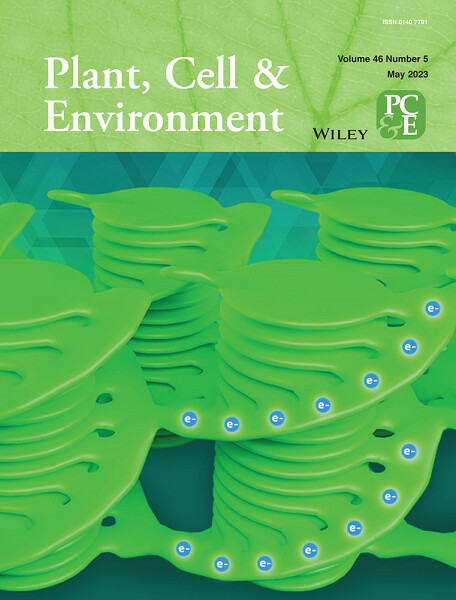
The cover image is based on the Original Article An exploratory steady-state redox model of photosynthetic linear electron transport for use in complete modelling of photosynthesis for broad applications by Lianhong Gu et al., https://doi.org/10.1111/pce.14563.
ISSUE INFORMATION
COMMENTARY
Complex regulation of flowering by high temperatures
- Pages: 1423-1426
- First Published: 22 February 2023
ORIGINAL ARTICLES
High ambient temperature impacts on flowering time in Brassica napus through both H2A.Z-dependent and independent mechanisms
- Pages: 1427-1441
- First Published: 27 December 2022
Ambient temperature is critical to set the timing for flowering and farming practices. We have uncovered variability in flowering time in spring varieties of oilseed rape (OSR) under high ambient temperature and determined their transcriptomic profiles. We concluded that warm temperature delays flowering in these varieties by decreasing the expression of FT homologues, being BnaFTA2 a key candidate in temperature-dependent flowering control. Both H2A.Z-dependent and independent mechanisms control OSR flowering time under high ambient temperatures.
ZTL regulates thermomorphogenesis through TOC1 and PRR5
- Pages: 1442-1452
- First Published: 19 January 2023
A central clock component, ZEITLUPE (ZTL), is known to regulate thermoresponsive growth in Arabidopsis thaliana. However, its underlying mechanism remains poorly understood. This study demonstrates that ZTL regulates PIF4 activity as well as PIF4 expression through TOC1 (TIMING OF CAB EXPRESSION1) and PRR5 (PSEUDO-RESPONSE REGULATORS5), thereby promoting thermomorphogenesis.
ABA-triggered ROS burst in rice developing anthers is critical for tapetal programmed cell death induction and heat stress-induced pollen abortion
- Pages: 1453-1471
- First Published: 23 January 2023
High temperatures (HT) disturbed the cellular distributions of ABA and ROS contents in rice anthers. The higher ABA in HT-stressed anthers contributed to HT-induced pollen abortion by activating ROS generation and oxidation in developing anthers. Interactions between SAPK2 and DEAD-box ATP-dependent RNA helicase elF4A-1 (RH4) were required for ABA-induced ROS generation during pollen development and its response to HT exposure.
Dissecting succulence: Crassulacean acid metabolism and hydraulic capacitance are independent adaptations in Clusia leaves
- Pages: 1472-1488
- First Published: 09 January 2023
Many succulent taxa use crassulacean acid metabolism (CAM) and elevated hydraulic capacitance (CFT) to buffer leaf water potentials. We show that CAM and elevated CFT are independent traits across the genus Clusia and that these adaptations have distinct impacts on plant performance during drought.
Drought survival and recovery in grasses: Stress intensity and plant–plant interactions impact plant dehydration tolerance
- Pages: 1489-1503
- First Published: 19 January 2023
Dehydration tolerance confers drought survival but varies significantly with stress intensity. We show that meristem dehydration is likely to cause plant mortality in grasses and that drought acclimation and plant–plant interactions impact dehydration tolerance and post-drought recovery.
Suppression of cuticular wax biosynthesis mediated by rice LOV KELCH REPEAT PROTEIN 2 supports a negative role in drought stress tolerance
- Pages: 1504-1520
- First Published: 23 January 2023
Loss of LOV KELCH REPEAT PROTEIN 2 (OsLKP2) function results in drought tolerance in rice due to an elevated total wax load on leaf surfaces through upregulated expression of wax-related genes. In the nucleus, OsLKP2 interacts with GIGANTEA, whose null mutant also shows enhanced drought tolerance.
Hydrogen sulfide upregulates the alternative respiratory pathway in mangrove plant Avicennia marina to attenuate waterlogging-induced oxidative stress and mitochondrial damage in a calcium-dependent manner
- Pages: 1521-1539
- First Published: 19 January 2023
H2S reduces mitochondrial ROS production by increasing the expressions of the alternative oxidase gene (AOX) and increases the proportion of alternative respiratory pathway in the total respiration, while H2S alleviates the mitochondrial structural damages including loss of bilayer membranes and blurring of mitochondrial cristae, and functional damages such as decrease of mitochondrial membrane potential (ΔΨm), membrane permeability transition pores opening, Cyt c release and the blockage of electron transfer along the mitochondrial electron transport chain caused by waterlogging-induced oxidative stress. Secondly, H2S enhances the capacity of the antioxidant system through upregulating the expression of SOD, CAT, and APX genes to scavenge excess ROS. Last, H2S induces Ca2+ influx in the roots under waterlogging. Our results provide the better understanding of the role of H2S in adaptation of mangrove plants to the coastal intertidal environment from the mitochondrial aspect.
An exploratory steady-state redox model of photosynthetic linear electron transport for use in complete modelling of photosynthesis for broad applications
- Pages: 1540-1561
- First Published: 09 February 2023
How redox reactions control photosynthetic electron transport (PET) is key to understanding PET regulation and linkage between light and carbon reactions. A steady-state photochemical model of redox control of PET is developed and tested, filling a major gap in complete modelling of photosynthesis.
Low light stress promotes new tiller regeneration by changing source–sink relationship and activating expression of expansin genes in wheat
- Pages: 1562-1581
- First Published: 25 January 2023
Low light stress changed source–sink relationship by regulating the expression of sugar metabolism genes and sugar transport genes as well as hormone content in spike, uppermost internode and tiller node. Meanwhile, expansin genes integrated the sugar pathway and hormone pathway and regulated the formation of new tillers.
FAR-RED ELONGATED HYPOCOTYL3 increases leaf longevity by delaying senescence in arabidopsis
- Pages: 1582-1595
- First Published: 31 January 2023
The transcription factor FHY3 participates in multiple signalling pathways to increase leaf longevity by preventing chlorophyll degradation and delaying leaf senescence in Arabidopsis.
γ-Glutamyl-transpeptidase CsGGT2 functions as light-activated theanine hydrolase in tea plant (Camellia sinensis L.)
- Pages: 1596-1609
- First Published: 09 February 2023
Theanine, endowing tea with health effects and umami taste and accounting for 1%–2% of the constituents in dry tea leaves, is an amino acid that is not used in protein synthesis but stores nitrogen in tea plants. However, theanine hydrolase, a key enzyme in theanine metabolic pathway in vivo, remain rarely unknown. Here we demonstrate that light-activated CsHY5–CsGGT2 pathway and theanine hydrolase activity of CsGGT2 in tea trees, which would provide theoretical basis for tea tree management and tea quality improvement.
Ca2+ deficiency triggers panicle degeneration in rice mediated by Ca2+/H+ exchanger OsCAX1a
- Pages: 1610-1628
- First Published: 24 January 2023
Panicle degeneration in rice severely curbs yield. In this study, a new apical panicle degeneration mutant was obtained and panicle degeneration gene OsCAX1a was identified, which was involved in Ca2+ transport through tonoplast. To the mutant, Ca2+ transport to apical tissues was restricted and over-accumulated in the rice sheath. The Ca2+ deficiency resulted in the burst of ROS and programmed cell death in the apical panicles of the mutant.
Cation diffusion facilitator proteins of Beta vulgaris reveal diversity of metal handling in dicotyledons
- Pages: 1629-1652
- First Published: 25 January 2023
Cation diffusion facilitators, called metal tolerance proteins (MTPs) in plants, mediate the transport of metals out of the cytosol. Roles of these transporters in metal homeostasis have been inferred mainly from work on model species. It is unclear to what extent these findings can be generalized. Here we show that sugar beet MTPs often deviate from their Arabidopsis counterparts in terms of substrate spectrum, subcellular localization, as well as transcriptional regulation upon exposure to Fe, Mn, and Zn deficiency and Mn and Zn toxicity. The results indicate a diverse employment of these proteins in phylogenetically distant dicots.
Regulatory module WRKY33-ATL31-IRT1 mediates cadmium tolerance in Arabidopsis
- Pages: 1653-1670
- First Published: 04 February 2023
RootSlice—A novel functional-structural model for root anatomical phenotypes
- Pages: 1671-1690
- First Published: 28 January 2023
Root anatomy remains an underutilized target for crop breeding. RootSlice, a multicellular functional-structural model of root anatomy, simulates the costs and benefits of diverse root anatomical phenotypes to estimate their utility for plant fitness in unfavourable soil environments.
The function of the Medicago truncatula ZIP transporter MtZIP14 is linked to arbuscular mycorrhizal fungal colonization
- Pages: 1691-1704
- First Published: 18 January 2023
The ZIP transporter gene MtZIP14 was highly up-regulated by arbuscular mycorrhizal fungal colonization in a transcriptomic screen of Medicago truncatula roots. Following characterization, MtZIP14 presents as a potential candidate for the facilitation of zinc transport via the mycorrhizal pathway of nutrient uptake.
Multispecies comparison of host responses to Fusarium circinatum challenge in tropical pines show consistency in resistance mechanisms
- Pages: 1705-1725
- First Published: 21 December 2022
F. circinatum resistant pines showed higher constitutive sulfur and flavonoid metabolism gene expression and susceptible hosts showed compromised induced responses. Counteracting these compromised pathways through hormone treatment or nutrient supplementation could improve pine resistance.
PIF8-WRKY42-mediated salicylic acid synthesis modulates red light induced powdery mildew resistance in oriental melon
- Pages: 1726-1742
- First Published: 09 February 2023
We found that CmPIF8, as a negative regulator of SA biosynthesis, inhibits CmWRKY42 transcriptional activation by binding to the CmWRKY42 promoter, and thus inhibits transcriptional activation of CmICS by CmWRKY42. Also, CmPIF8 binds to the CmICS promoter and directly inhibits its transcription.
ERRATUM
Correction to “The fine-tuning of mycorrhizal pathway in sorghum depends on both nitrogen−phosphorus availability and the identity of the fungal partner”
- Page: 1743
- First Published: 14 March 2023




